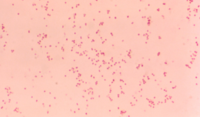
Photo from wikipedia
Recovery of Neisseria gonorrhoeae isolates exposed to a range of transport times and temperatures was quantitatively assessed for two transport devices, BioMed Diagnostics’ InTray GC® and Copan Diagnostics’ Liquid Amies… Click to show full abstract
Recovery of Neisseria gonorrhoeae isolates exposed to a range of transport times and temperatures was quantitatively assessed for two transport devices, BioMed Diagnostics’ InTray GC® and Copan Diagnostics’ Liquid Amies Elution Swab (ESwab®) Collection and Transport System. Respective devices were inoculated with N. gonorrhoeae, exposed to simulated transport conditions and spread-plated from serial dilutions in duplicates onto chocolate agar in order to count CFU (colony-forming units) in the range of 25–250. Baseline CFU/mL averages of time-zero transport for each device was compared to either 24 hour (Eswab) or 72 hour (InTray GC) CFU/mL average to assess recovery of six clinical isolates of N. gonorrhoeae, and differences showing no greater than a 3 log10 (± 10%) decline between comparative time points qualified as acceptable. Our findings suggest that the InTray GC system has the potential to transport clinical isolates for ≤72 hours with acceptable N. gonorrhoeae recovery.
Journal Title: PLoS ONE
Year Published: 2022
Link to full text (if available)
Share on Social Media: Sign Up to like & get
recommendations!